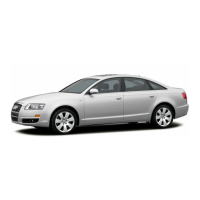
Do you have a question about the Audi A6 2005 - Electrics and is the answer not in the manual?
| Brand | Audi |
|---|---|
| Model | A6 2005 - Electrics |
| Category | Automobile |
| Language | English |
Diagram showing the location of various control units within the vehicle.
Diagram illustrating the network connections between vehicle control units.
Illustrations showing the locations of fuses and relays in the vehicle.
Details on the power management control unit and its functions.
Function diagram and legend for the access and start authorization system.
Overview of the Advanced Key system and its revised functions for the A6.
Breakdown of the access and start authorisation system into three basic modules.
Versions and functions of the ignition switch for access and start authorisation.
Functions of the control unit for access and start authorization, including steering column lock.
Description of the vehicle key's mechanical and electronic functions.
Function of the antenna read-in unit in evaluating door handle sensor signals.
Details on capacity-based sensors in outer door handles and their signals.
Location and function of the four transmitting antennae used for radio communication.
How the start/stop button functions and is evaluated for safety.
Diagram and explanation of the vehicle unlocking process using keyless entry.
Diagram and explanation of the engine start process using the start button.
Description of Immobiliser 4 technology and integrated components.
Procedure for replacing stolen control units with the 'New Identity' function.
Explanation of component protection for Convenience and Infotainment units.
Overview of the different types of front headlights used in the A6.
Overview of the three types of front headlights used in the Audi A6 '05.
Details on standard halogen headlights, lamp types, and country variants.
Description of XenonPlus headlights, lamp types, and country variants.
How adaptive light works as a dynamic corner-sensitive headlight.
Explanation of the inductive pickup and power module in the adaptive light system.
How input variables are used for calculating pivot angle and dynamic control.
Function to pivot headlights for presentation purposes, adaptable via diagnosis tester.
Overview of the different types of tail lights used in the A6.
Details on basic ECE tail lights, lamp activation, and sections.
Features of High ECE back lights, including LED brake lights and fog/reversing light placement.
Details on SAE back lights for North American market, including LED units and fog/reversing lights.
How LED failures are detected and reported in the lamp housing.
Variants and functions of the dash panel insert control unit.
How the system indicates exterior lighting lamp failures via symbols and text.
How the outside temperature is displayed, using two sensor inputs.
Functions of the on-board power supply control unit.
How the control unit implements emergency functions in case of faults.
Additional functions managed by the on-board power supply control unit.
Description of the three functional versions of the control unit.
Diagram showing connections for control unit J519, headlights, and other components.
Input signals evaluated and loads controlled by the J519 unit.
Procedures for basic settings, actuator tests, and coding the J519 unit.
Function of the combined rain and light sensor and its connection to the control unit.
How the light sensor registers ambient conditions in two areas.
Functions of the rain sensor, including wiper control and driving light activation.
How the rain sensor registers moisture using light refraction principles.
Functionality and integration of the wiper motor control unit.
Functions and versions of the additional on-board power supply control unit.
Integration of the tilt sensor into control unit J520 and its function.
Tasks and functions of the central convenience system control unit.
Location of the central convenience system control unit in the boot.
Input signals received and loads activated by the J393 control unit.
Standard and additional equipment functions for interior lighting.
Diagnostic functions, actuator tests, and coding options for the convenience system.
Description of parking aid systems, versions, and installation.
CAN bus messages required and output signals for the parking aid control unit.
Functionality, diagnosis, and versions of door control units.
Input signals received and loads activated by door control units.
Setup and diagnosis of control units for electrically adjustable seats.
Signals from switches and door units to the seat adjustment control unit.
Using MMI to align passenger seat symmetrically with the driver's seat.
Adjusting passenger seat for better B-pillar visibility via MMI.
Ways to retrieve stored seat memory settings: personal buttons or radio code.
Overview of MMI versions and data transfer via MOST bus technology.
Standard equipment for MMI Basic, including display, tuner, CD drive, and amplifier.
MMI Basic with additional functions like TP Memo for traffic announcements.
MMI Basic with integrated navigation module for optical and audible route guidance.
MMI High features: color display, dual-tuner, sound system, CD changer, optional DVD navigation.
Details on destination entry, route criteria, map features, and setup options.
Overview of menus for TMC messages, user management, and vehicle maintenance.
Overview of antenna modules integrated into the rear window for various systems.
Functions of the J523 unit for MMI versions, installation, and hardware.
Overview of address words and available diagnostic functions for J523 modules.
Detailed list of measured-value blocks for various modules and their designations.
Table detailing decimal places and descriptions for coding control unit J523.
Location of infotainment control units, primarily in the boot and dash panel.
Overview of different sound system versions and their components.
Overview of fixed and mobile baseplate telephone systems and their integration.
How voice operation works with the mobile baseplate and MMI systems.
How handsfree operation signals are processed and echo compensation is managed.
Diagnosis procedures, including actuator tests and signal checks for the mobile baseplate.
List of measured-value blocks available for diagnosing the mobile baseplate.
Possible actuator tests for the mobile baseplate, including selective activation.
Adaptation channels and their designations for configuring the mobile baseplate.
